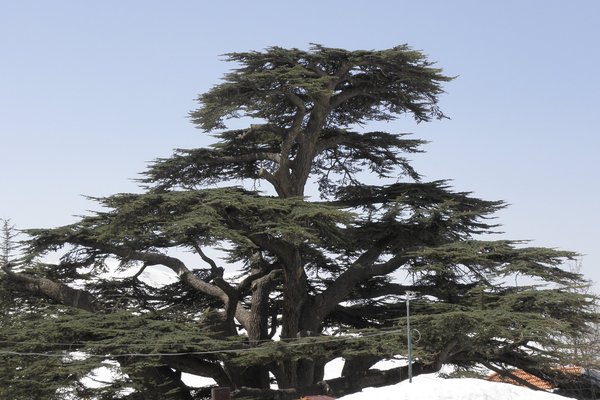Lebanon
Qadisha Valley
The Ouadi Qadisha (the Holy Valley) and the Forest of the Cedars of God (Horsh Arz el-Rab) is a cultural landscape encompassing early Christian monastic settlements and a rare forest of Cedar trees.
The valley has been a place of meditation and refuge since the earliest years of Christianity. The current communal and eremitic monastic complexes are mostly Maronite and are supported by terraces used for cultivation. The nearby Cedar Forest is seen as a sacred forest. It holds the remaining specimens of a great forest that supplied prized building materials and gave Lebanon its fame in Antiquity.
Community Perspective: best visited on a day tour or using private transport, as it is in a remote mountainous location. Juha hiked through the area and visited a number of its monasteries and chapels along the way.
Site Info
Official Information
- Full Name
- Ouadi Qadisha (the Holy Valley) and the Forest of the Cedars of God (Horsh Arz el-Rab) (ID: 850)
- Country
- Lebanon
- Status
-
Inscribed 1998
Site history
History of Qadisha Valley
- 1998: Inscribed
- Inscribed
- 1993: Rejected
- "Cedars of Lebanon" was rejected: too small - should look at larger "Cultural Landscape"
- Type
- Cultural
- Criteria
- iii
- iv
Links
- UNESCO
- whc.unesco.org
- Official
-
- visit-lebanon.org — Visit Lebanon
All Links
UNESCO.org
- whc.unesco.org — whc.unesco.org/
Official Website
- visit-lebanon.org — Visit Lebanon
News Article
- May 20, 2010 naharnet.com — UNESCO Threatens to Remove Qadisha Valley from World Heritage List
Community Information
- Community Category
- Religious structure: Christian
- Cultural Landscape: Associative
Travel Information
Recent Connections
-
Cedar forests
"the Forest of the Cedars of God is the…
-
Named after a Tree Species
"one of the rare sites where the Cedrus… -
Named after a River
"The Holy River Qadisha, celebrated in …
Connections of Qadisha Valley
- Individual People
-
-
Baibars
At the end of the Crusades the Qadisha caves witnessed dramatic actions against their supporters, the Maronites. The Mameluk Sultans Baibars and Qalaoun led campaigns in 1268 and 1283 respectively against these fortress-caves and the surrounding villages. (AB ev) -
Johann Ludwig Burckhardt
Oct 2nd - 4th 1810
-
- Trivia
-
-
Minority communities
"Syrian Maronites fled there from religious persecution from the late 7th century onwards" (AB evaluation) -
Depicted on National Flag
Forest of Cedars -
Depicted on National Coat of Arms
Lebanon, Cedar tree -
On Passports
Cedar TreeSee en.wikipedia.org
-
- History
-
-
The Crusades
"Comme la grotte de Hauqua, celle de Hadath servit de refuge pendant les temps troubles de la fin de Croisades. A deux reprises, en 1268 et en 1283 les habitants du village de Hadath, poursuivis par les armees Mameloukes de Baybars et Qalaoun, s'enfuirent vers cette grotte forteresse. Il est possible que lors de las premiere campagne des Francs aient fait partie des refugies. La siege de la seconde campagne dura une quarnantiaine de jours. Le patriarche de Hadath, inquietant autant les Musulmans que les Croises, aurait ete capture dans cette grotte" (Nom file) -
Palaeolithic and Mesolithic
"Many of the caves in the Qadisha occupied by the Christian anchorites had been used in earlier as shelters and for burials, back as far as the Palaeolithic period." (AB evaluation)
-
- Ecology
-
-
Cedar forests
"the Forest of the Cedars of God is the last vestige of antique forests and one of the rare sites where the Cedrus lebani still grows" (OUV statement)
-
Notable Trees
Cedrus lebani
-
- Architecture
-
-
Cave Temples or Churches
-
Cave dwellings
-
Rock Cut Architecture
Qannubin Monastery and others
-
- World Heritage Process
- Religion and Belief
-
-
Eastern Catholic Churches
Maronite churches -
Syriac Churches
Maronite churches -
Sacred Forests or Groves
"The ancient text known as the Epic of Gilgamesh, found in central Mesopotamia, makes reference to this forest and describes the Cedars of Lebanon as sacred trees." (AB) -
Ethiopian Orthodox
The hermitage-monastery complexes of Deir es-Salib, Mar Antonios, Mar Semaane, and Mar Assia, along with the isolated chapels of Mar Bohna and Mar Chmouna were all established by Ethiopian Orthodox monks.
-
- Human Activity
-
-
Secret Locations
Early Christian sects fleeing persecution found refuge in the Kadisha. Among these groups were the Jacobites (Syrian Orthodox), Melchites (Greek Orthodox), Nestorians, Armenians, and even Ethiopians. The Maronites, however, are the dominant Christian group in the valley. -
Mummies
Maronite mummiesSee en.wikipedia.org
-
Man-made Terraces
agricultural terraces
-
- Constructions
-
-
Cultural sites connected to Cliffs
Hermitages
-
- WHS on Other Lists
-
-
Most beautiful villages
Hasroun, Hadath el-Jebbeh and Bcharreh are among Lebanon’s “Les plus beaux village du Liban”. -
U.S. Ambassadors Fund
Restoration of the Mid-12th-Century Mar Bichay Hermitage in Qadisha Valley (2004) -
Memory of the World
Commemorative stela of Nahr el-Kalb, Mount Lebanon
-
- Timeline
-
-
Built in the 4th century
The Cultural OUV of the site is based upon the continuous use of the area by monastic communities (Monasteries and eremetic caves) since the earliest years of Christianity. Among these in particular were the 'Maronites' who founded monasteries there and, from 5C, faced repeated persecution for their 'heretical' beliefs. From 7C they were effectively isolated until the Crusades in their mountain valley from Byzantine Christians by the spread of Islam and set up their own Patriarch in 687. Of the major monasteries, those of Qannubin and St Anthony of Quzhayya, were traditionally founded in 4C (though possibly in reality somewhat later) whilst those of Our Lady of Hauqqa and St Elisha were founded in 13 and 14C respectively
-
- WHS Hotspots
- Science and Technology
-
-
Early Printing
The first printing press in the middle east was built in 1610 at the Monastery of Qozhaya in the Kadisha valley. It used Syriac characters. Also this printing press was the first to print in Arabic language.
-
- WHS Names
-
-
Named after a River
"The Holy River Qadisha, celebrated in the Scriptures, runs through the Valley." (OUV) -
Named after a Tree Species
"one of the rare sites where the Cedrus lebani still grows"See en.wikipedia.org
-
- Literature & Film
News
- naharnet.com 05/20/2010
- UNESCO Threatens to Remove Qadisha…
Recent Visitors
Visitors of Qadisha Valley
- Afshin Iranpour
- Alexander Lehmann
- Ali Zingstra
- Aspasia
- Atila Ege
- Bill Maurmann
- Bin
- Boj
- Bram de Bruin
- Chantal den Haan
- Christian Wagner
- Christravelblog
- Delphine Delaunay
- Els Slots
- Erik Jelinek
- Errol Neo
- Eva Kisgyorgy
- Fan Yibo
- George Gdanski
- giloudepuertorico
- Hadrianus
- Harry Mitsidis
- henryjiao18
- Iain Jackson
- Ivan Rucek
- Jarek Pokrzywnicki
- Jeffrey Chai
- João Aender
- Joyce van Soest
- Juha Sjoeblom
- KentishTownRocks
- Krijn
- Little Lauren Travels
- Loic Pedras
- Luis Filipe Gaspar
- Lukasz Palczewski
- Maciej Gil
- Malgorzata Kopczynska
- marcel staron
- Martina Rúčková
- Mikan22
- Milan Jirasek
- Miloš Tašković
- MMM
- MoPython
- Nihal Ege
- palka25
- PeterH
- Philipp Peterer
- Piotr Wasil
- Randi Thomsen
- Roger Ourset
- Roman Bruehwiler
- Sergio Arjona
- Solivagant
- Stanislaw Warwas
- Svein Elias
- Szucs Tamas
- Tarquinio_Superbo
- Thomas Buechler
- Thomas van der Walt
- Timothy C Easton
- tony0001
- triath
- Vernon Prieto
- Walter
- Zoë Sheng
Community Reviews
Show full reviews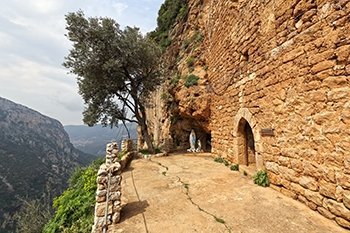
Site visited March 2019. Qadisha Valley was the site that I looked forward the most in Lebanon after Baalbek. And it didn’t disappoint my expectations. During my hike I visited three out of four of the main monasteries of the valley and saw some spectacular sceneries. In this review I focus only on the Qadisha Valley, not on the Cedars of God.
The dramatic and rugged Qadisha Valley is one of the oldest and most important early Christian monastic settlements. Valley formed a natural rampart which sheltered these early monastic communities. Maronite hermits found refuge in a multitude of almost inaccessible caves and rock-cut monasteries. Around these shelters the monks and hermits had turned the slopes into terraces to grow grain, grapes and olives.
This is one of the World Heritage Sites that are best experienced by foot. That is because many of the most interesting monasteries, churches and caves are located on the slopes of the valley that are not reachable by car. Hiking is also the best way to enjoy the great views and nature around you.
It was quite clear that I wanted to visit Qadisha Valley by hiking. At first I thought about independent hiking option but I found it too difficult. Distances are quite big and I couldn’t find good enough map of hiking routes. Private hiking tours are very expensive. The only alternative was to participate a group tour. I’m not really a group tour kind of traveller but I can …
Keep reading 0 comments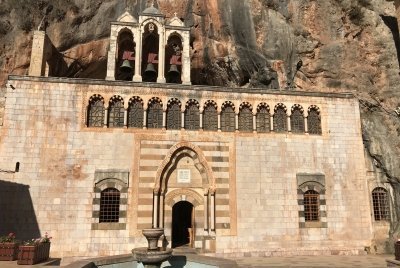
Qadisha Valley has gorgeous views and very pretty nature. We arrived via a scenic route, through a mountain pass Bcharee from Bekaa Valley. There is Cedar of Gods cedar tree reserve and some monasteries included in the inscription. Some are only reached on foot via some hikes. As I am not very keen on those, Ivan took Els' advice from her review and chose the Monastery of St. Anthony of Khozaia which can be reached via car all the way to the entrance gate. Check your maps as the turn from the main road is quite sudden. The monastery has a church that is carved into a cave and a quirky cave shrine all in dark, except for the illuminated statue of the hermit. The views from the monastery are stunning and the monastery very peaceful. We enjoyed it very much.
You can spend a day in Qadisha Valley if you wish to, taking numerous hikes, visiting the Deir Mar Elisha - a monastery turned into a museum or the other monasteries. Best way is to have your own car, or you can arrange a day tour from Beirut.
Keep reading 0 comments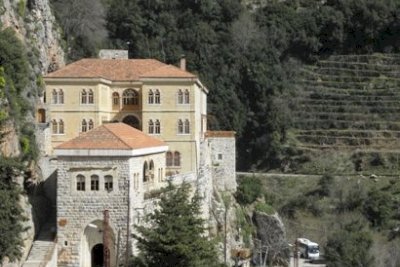
This is a whole different side of Lebanon, and worth the trek out to the north of Mount Lebanon. I went there on a day tour with Nakhal Tours, a popular and well-organized tour company from Beirut which I had also used for Baalbek/Anjar. There are public buses too, to the town of Bcharré for example, but it would be too much to visit the monasteries and the cedars in one day that way.
We first drove up in the mountains, already enjoying fine vistas over the Qadisha Valley and the villages around it with their large churches and red-roofed houses. I had seen snow on the mountain tops on my way to the Bekaa Valley too, but here you're much higher (about 2,000 m above sea level). There are ski resorts also. No wonder the 'Forest of the Cedars' was covered in snow about 1 - 1,5 meters high. The 'Forest' is a pitiful patch of a few hundred trees, leaving some of my fellow tourmates wondering why we had travelled for hours to just see that. It is quite a touristy spot however, the road along the forest is packed with souvenir stalls. There were other tour buses full of Lebanese daytrippers also.
After half an hour or so, having photographed every single remaining cedar, we went back into the bus to descend into the valley. This is an exciting ride, as we had a big touring car bus and the road is very narrow and …
Keep reading 0 comments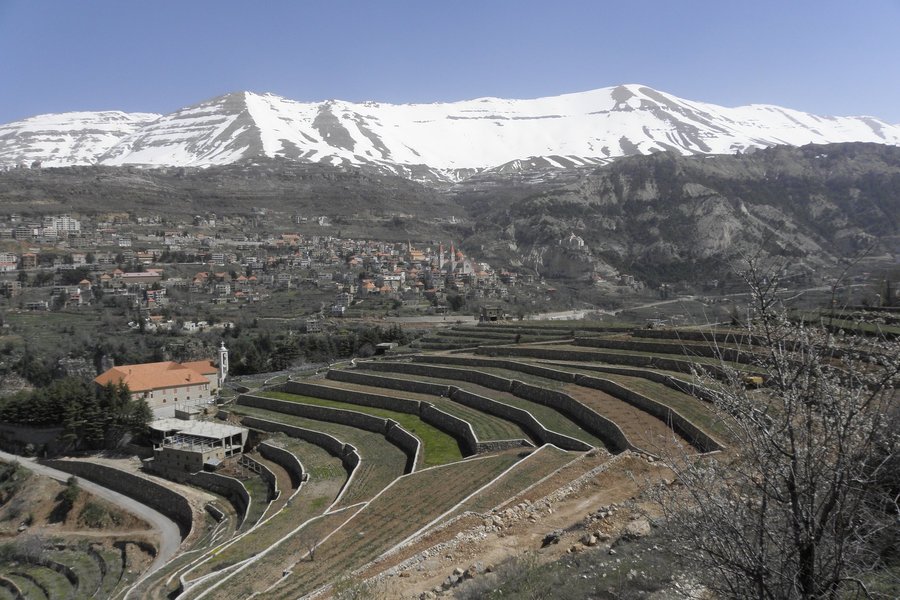
The most beautiful site on earth,
I came to The Lebanon ( land of my Father )for my second time in 1994, the first time was in 1989 but I was unable to visit the Holy Cedars because of the war, so in 1994 my cousins Carlos, Kerellos and Carla Keyrouz drove me to the Holy Ceaders.
The drive there wes absolutely beautiful but the sight of this magnificent Forrest of God was breath taking, I wish the whole world could see them, I have NEVER forgotton this experience, I pray to God my health will allow me to see them just once more.
I have searched for paintings or prints of the Cedars but so far I have not been able to find them, that is why I am on the net now and found your site.
Keep up the good work
May God Bless you and keep you in good health now and Always
Chris Karooz
Keep reading 0 comments
